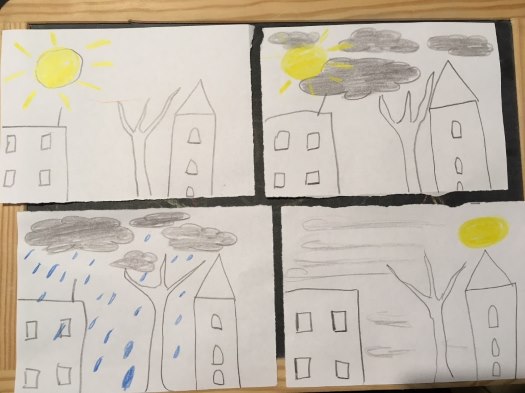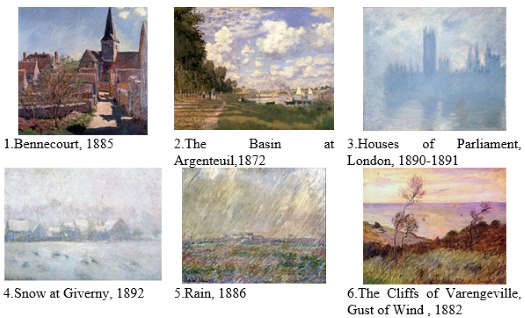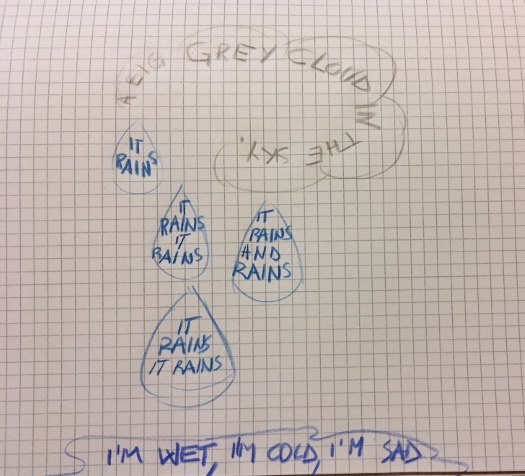What’s the WeathART Like?
Elisa Bertoldi, Italy
Elisa Bertoldi is a Primary School teacher of English. She has ten years of experience in working with children from 6 to 11 years old. She’s also temporary Research Fellow at the Department of Languages, Literatures, Communication, Education and Society (University of Udine, Italy). She’s interested in new technologies applied to foreign language teaching. E-mail: elisa.bertoldi@goiss.it
Menu
Lesson plan
Context
Warmer
Activity 1
Breaker 1
Activity 2
Breaker 2
Activity 3
Round-off
The role of creativity in my classroom
References
This lesson plan was carried out with a Fourth class of an Italian primary school; there were 20 8-9-year-old pupils. They had one-hour English lesson three times a week.
Level: A1
Language aims
- To revise vocabulary related to weather conditions.
- To use the simple present and the present continuous of the verb “to be” to describe an image using details related to weather conditions.
- To introduce the simple past and adverbs of time (this morning, then, now) to describe changing weather conditions.
Educational aims
- To be able to observe and capture details on how the same scene looks in different weather conditions taking inspiration from Monet paintings.
- To teach children to focus their attention on a painting, gathering the visual information needed for them to give a personal response to it.
(8 minutes) “Weather Changing time lapse”
I start the lesson showing children a YouTube video about changing weather time lapse (This is one of my favorites: https://www.youtube.com/watch?v=VRC5sV1iI_U). After watching the video, I divide the class into groups of four and I give to each group four small sheets of paper. In their groups they can choose and draw a very simple landscape, each child draws the same landscape on a different piece, then each member of the group modifies the landscape choosing a weather condition. At this point the group decides the sequence of weather conditions and presents a “changing weather time lapse” showing the drawings to the class and describing how the weather is changing. All sequences are transformed into classroom posters.

(10 minutes) “Jump in and take a walk”

I divide children into pairs. I show them on the interactive whiteboard six paintings by Claude Monet; each one of them represents a different weather condition.
Each pupil chooses one of the paintings and tries to imagine jumping in it and taking a walk in the scene. I write some questions on the smart board in order to guide them during their visualization (What do you feel? Cold? Hot? How are you? What can you see? A town? A village? Nature? What can you hear? What are you wearing?) Then, using the questions, each child gives information to the classmate in order to help him/her guessing where he/she is. They can’t mention the weather condition. When a child guesses the painting, he/she should say “You are in painting number… and it’s…. (what’s the weather like?)”
(1 minute)
I ask children to tap their index finger on the palm of their hands to try reproducing the sound of rain. They should start slowly and then increase the speed.
(15 minutes) “What if…?”
Each child can choose one of the paintings of the first activity and try to imagine and represent it on a sheet of paper with a different weather condition. I prepare a poster divided into two columns: in the first column there are the original paintings by Monet, in the second one there are the children’s version of the paintings. When the children finish their drawings, they can hang their painting on the poster and tell the class “In this painting it was (sunny, foggy, rainy), but now it is (cloudy, windy, snowy).
(3 minutes)
We watch the video YOGA FOR KIDS: SUN SALUTATION
https://www.youtube.com/watch?v=dpMwFqLmNrQ and reproduce the movements.
(10 minutes): “Paintings tell us stories”
I divide children into groups of four. Each group has a series of 3 Monet paintings. I write on the board the beginning of three sentences. Children should create a short story completing the sentences in their groups and deciding the sequence of pictures. Then they can match each picture with one of the sentences.
- THIS MORNING IT WAS…
- SUDDENLY IT (BECAME or STARTED) …
- NOW IT IS…

In their groups of four, children should choose a weather condition and write a shape poem using structures and words they have used or learnt during the lesson and that come to their minds.

There are many ways to be creative, each child has his/her own way to be creative and to use creativity, but I think that the most they are familiar with an activity the most they become creative in doing it. As children grow and develop their language skills they can become more and more creative with the language. I clearly remember an episode that happened to me at the beginning of my career.
It was September 2007, I was a supply teacher in a small primary school. It was my first experience as English teacher. I was in the classroom with seventeen children of seven years old and the topic of the lesson was “Fruit of Autumn”. I brought to school a basket full of fruit to show to the children, there were grapes, pumpkins, pears, apples and chestnuts.
To make them interact in English I started asking pupils what was there in the basket, how many pears and apples they could see or what colours and shapes they could see. Children seemed confused and I couldn’t understand what was happening, they didn’t answer. I was sure we were talking about things they already knew (numbers, colours, shapes). Suddenly a child raised up his hand and asked me “Teacher, we’re a second class of Primary school, we did all these things last years… numbers, colours and shapes, why are you asking us about them?”.
I was surprised of that question but soon I realized that it was coherent with the way they had learned English until that moment: their language learning process was a sort of “list of topics” and there were no connections among topics, they were just learning lists of words and they were not able to use them in a context to communicate.
From that day I decided that my aim, as an English teacher, would have been to teach children language not starting by a topic but starting by a purpose. When I give pupils a purpose for using the language they become more creative because they are motivated in finding ways to communicate and interact. In my teaching practice I try to make them feel confident with the foreign language in order to stimulate them to create opportunities to communicate with classmates being flexible and adapting the language they know to different interactive contexts.
I ask pupils to create poems, create recipes, write stories about…, pretend to be someone else and act. In this way children learn how to use the language as a tool to communicate connecting different topics, using structures in a flexible way to talk about a huge variety of topics, combining sentences and words being creative with the language.
https://www.nationalgallery.org.uk/learning/teachers-and-schools/teaching-english-and-drama/how-to-read-a-painting?viewPage=2

Please check the Creative Methodology for the Classroom course at Pilgrims website.
Please check the Methodology and Language for Primary course at Pilgrims website.


|